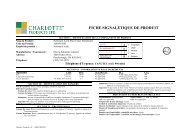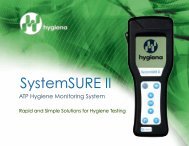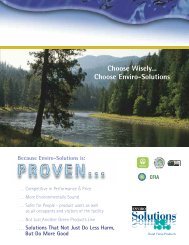Environmental Claims in Consumer Markets Summary Report North America April 2009
Environmental Claims in Consumer Markets - The Sins of ...
Environmental Claims in Consumer Markets - The Sins of ...
Create successful ePaper yourself
Turn your PDF publications into a flip-book with our unique Google optimized e-Paper software.
TM3.Key F<strong>in</strong>d<strong>in</strong>gsThe data from the <strong>2009</strong> Seven S<strong>in</strong>s of Greenwash<strong>in</strong>grevealed both good news and bad. They also po<strong>in</strong>t toearly evidence of what may be two significant new trends.These are the key f<strong>in</strong>d<strong>in</strong>gs:• More products are mak<strong>in</strong>g environmental claims.In stores that were visited <strong>in</strong> both 2007 and2008/<strong>2009</strong>, the number of ‘green’ products 4<strong>in</strong>creased by 40% to 176% per store. This was anaverage <strong>in</strong>crease of 79%, provid<strong>in</strong>g further evidencethat manufacturers and marketers are respond<strong>in</strong>gto consumer demand for more environmentallyresponsible goods. This is good news. Althoughgreenwash<strong>in</strong>g is still a problem (see below), thisfundamental <strong>in</strong>crease <strong>in</strong> ‘green’ product selection isa strong signal that the green consumer movementis hav<strong>in</strong>g good effect.(This <strong>in</strong>crease <strong>in</strong> ‘green’ products is corroboratedby the <strong>in</strong>crease <strong>in</strong> green advertis<strong>in</strong>g found <strong>in</strong> otherTerraChoice research. S<strong>in</strong>ce 2006, green advertis<strong>in</strong>ghas almost tripled (Exhibit 1).)Legitimate eco-label<strong>in</strong>g is almost twice ascommon <strong>in</strong> this study (23% of products) as itwas <strong>in</strong> the 2007 research (14% of products).• A new S<strong>in</strong> has emerged – the S<strong>in</strong> of ‘Worship<strong>in</strong>gFalse Labels’. This new S<strong>in</strong> describes an effort bysome marketers to exploit consumers’ demand forthird-party certification with fake labels or claims ofthird-party endorsement. This is described <strong>in</strong> detail<strong>in</strong> Section 3.1.• Legitimate Eco-Label<strong>in</strong>g is on the rise.Legitimate eco-label<strong>in</strong>g is almost twice as common<strong>in</strong> this study (23% of products) as it was last year(14% of products). For this test, we recognized 14labels as ‘legitimate’. Among others, these <strong>in</strong>cludelegitimate ecolabels <strong>in</strong>clude EcoLogo, FSC,Green Guard, GreenSeal, and SFI.Proof is a central element of good green market<strong>in</strong>g,and a relatively easy one for marketers.• Greenwash<strong>in</strong>g is an <strong>in</strong>ternational challenge, withvery similar patterns <strong>in</strong> the United States, Canada,the United K<strong>in</strong>gdom, and Australia. This key f<strong>in</strong>d<strong>in</strong>gis described <strong>in</strong> detail <strong>in</strong> Section 3.3.Additional details, <strong>in</strong>clud<strong>in</strong>g methodology andnation-specific breakdowns of the results, areprovided <strong>in</strong> Appendices A through E.• Kids (toys & baby products), cosmetics and clean<strong>in</strong>gproducts (diapers, toothpaste, and w<strong>in</strong>dow cleaner,for example) are the three categories where greenclaims – and greenwash<strong>in</strong>g – are most common.These products, among the most common ofproducts <strong>in</strong> most households, deserve particularscrut<strong>in</strong>y from consumers. Each category is detailed <strong>in</strong>Section 3.2.• Greenwash<strong>in</strong>g is still abundant, with over 98%of ‘green’ products committ<strong>in</strong>g at least one of theS<strong>in</strong>s. The data show a m<strong>in</strong>or decl<strong>in</strong>e <strong>in</strong> the overallfrequency of greenwash<strong>in</strong>g, but it does not appearto be statistically significant. Of the 2,219 productsclaim<strong>in</strong>g to be green <strong>in</strong> the United States andCanada, only 25, or less than 2%, products werefound to be S<strong>in</strong>-free.79%Average <strong>in</strong>crease <strong>in</strong> the number of ‘green’products among <strong>North</strong> <strong>America</strong>n storesvisited <strong>in</strong> both 2007 and 2008/<strong>2009</strong>.4In this case, and <strong>in</strong> every case <strong>in</strong> this report, ‘green’ products is shorthand for ‘products-claim<strong>in</strong>g-to-be-green’(or other similar language or suggestion). In fact, few if any products can be correctly described as ‘green’. Mostof the best are still only ‘greener’ than the competitors.www.s<strong>in</strong>sofgreenwash<strong>in</strong>g.org








